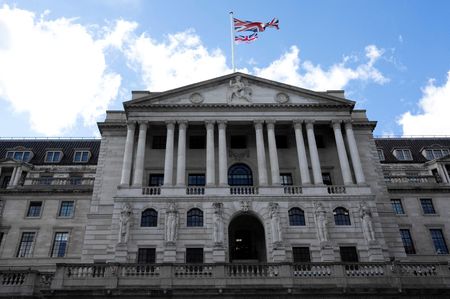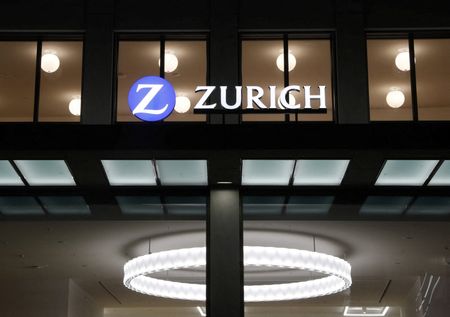By Alun John
LONDON (Reuters) -British bond yields rose on Thursday, sending the pound higher after the Bank of England cut interest rates as expected but concern over inflation among policymakers caused markets to reduce the number of rate cuts they expect in the rest of 2025.
Four of the BoE’s nine policymakers voted to keep rates on hold, with the Monetary Policy Committee needing two votes for the first time in its history to settle on a 25 basis point rate cut.
The BoE is being pulled in different directions as Britain’s job market has weakened in recent months, but inflation is rising – the BoE’s updated projections from Thursday show headline CPI peaking at 4% next month.
The second vote was required after one policymaker voted for a larger 50 basis point cut but, with four voting to hold, more policymakers are prioritising the inflation side of that equation than investors had thought prior to the meeting.
“Essentially the committee collectively is more concerned with the pace of disinflation, and that resulted in less willingness to cut rates across members than we had believed,” said Philip Shaw, chief economist at Investec.
“We are still for now forecasting a 25 bps cut to rates in November, but clearly we could be looking at another very finely balanced decision and the out-turn will, of course, depend on the data between then and now.”
Yields on British government bonds, or gilts, rose, and the rate-sensitive 2-year yield was last up 5 basis points at 3.88%.
Thursday’s move was the Bank of England’s fifth cut since August last year. Ahead of the meeting, markets had fully priced a further 25 basis point cut late this year, but the vote split caused traders to become less certain that would materialise.
Trading was choppy, but LSEG data last indicated around a 75% chance of another such rate cut this year.
The benchmark 10-year yield at one point rose more than 6 basis points at 4.597%, and was last at 4.57%.
Bank of England Governor Andrew Bailey, who voted to cut, said that he thought rates were still on a downward path.
But, he added: “There is, however, genuine uncertainty now about the course of that direction of rates.”
STRONGER STERLING
The pound rose after the decision, and was last up 0.55% on the dollar at $1.3424, and was stronger by a similar amount on the euro at 86.71 pence to the common currency.
That reaction to higher gilt yields is fairly typical, as currencies are often shaped by rate differentials between markets. But on several occasions this year, worries about Britain’s fiscal position have seen the pound fall as gilt yields rose.
A slower pace of Bank of England easing could support the pound further, and is causing some investors and analysts to reassess their positions on the British currency.
“We’ve been long euro-sterling for the last couple of months. It’s been a good trade and part of that has been the risk of a dovish BoE relative to a more hawkish ECB,” said Dominic Bunning, head of G10 FX strategy at Nomura.
“Today’s developments probably do put that position into question. It will certainly make us think about our conviction on that one.”
The European Central Bank is likely already at the end of its rate cutting cycle, but markets anticipate more rate cuts from the U.S. Federal Reserve.
Less BoE easing and higher yields are bad news for most stocks, however.
London’s blue-chip FTSE 100 index extended an earlier loss, and was last down 0.8%, with the mid-cap FTSE 250 index giving back earlier gains to trade just below flat.
The broad European benchmark was up nearly 1%.
(Additional reporting by Stefano Rebaudo and Danilo Masoni in Milan and Lucy Raitano and Samuel Indyk in London; Editing by Amanda Cooper, Ed Osmond and Alex Richardson)











